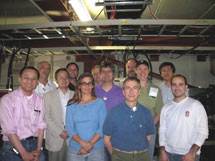symmetry Explains it in 60 Seconds: String Theory
by John H. Schwarz
String theory proposes that the fundamental constituents of the universe are one-dimensional
"strings" rather than point-like particles. What we perceive as particles are actually vibrations in loops of string, each with its own characteristic frequency.
String theory originated as an attempt to describe the interactions of particles such as protons. It has since developed into something much more ambitious: an approach to the construction of a complete unified theory of all fundamental particles and forces.
Previous attempts to unify physics have had trouble incorporating gravity with the other forces. String theory not only embraces gravity but requires it. String theory also requires six or seven extra dimensions of space, and it contains ways of relating large extra dimensions to small ones. The study of string theory has also led to the concept of supersymmetry, which would double the number of elementary particles.
Practitioners are optimistic that string theory will eventually make predictions that can be experimentally tested. String theory has already had a big impact on pure mathematics, cosmology (the study of the universe), and the way particle physicists interpret experiments, by suggesting new approaches and possibilities to explore.
Click here to view
symmetry's Explain it in 60 Seconds archive.
|

Keeping SLAC's
Water Clean
by María José Viñas
Water, water everywhere, but did you ever stop to think about where it goes and how we ensure that it is clean? Water flows from SLAC in three ways; rain or storm water is routed offsite through drainages and pipes, industrial and domestic wastewater is directed to a treatment plant through the sanitary sewer system, and groundwater slowly creeps through bedrock below SLAC.
San Francisquito Creek, running south of SLAC, is home to many native species,
including shorebirds from all over the South Bay and fish like the steelhead trout. All stormwater runoff from SLAC flows, untreated, to San Francisquito Creek.
A mission of the Environmental Protection Group is to ensure SLAC runoff contributes to the healthy flow of stormwater into the creek and down to the San Francisco Bay.
"An important aspect of our work is to help SLAC minimize impacts to the creek from our operations so it remains a healthy environment for the flora and fauna," says Susan Witebsky, environmental protection group leader in the Environmental, Safety and Health (ES&H) Division.
SLAC has a Storm Water Pollution Prevention Plan that requires monitoring of runoff as well as operations, and SLAC reports the results annually to the California Regional Water Quality Control Board.
Best Management Practices are applied to specific operations to minimize the potential for impact.
Witebsky says that SLAC is not allowed to put anything other than rain water into the storm drain system. "Not even drinking water, because the chemicals in it may be fine for us, but not for the fish," she says. In fact, the environmental protection group's motto is "Nothing but rain in the drain."
Read more...
|
Trailer Warming Party!
by Kelen Tuttle and Melinda Lee

It's a Trailer Party! Come revel in food, drinks, and even a tattoo bar this
Thursday afternoon at the Communication Office's new digs. It all starts at 3:00
p.m. outside
Trailers 266 and 267.
Bring yourself, bring your friends, bring your pet flamingo!
Collaborating
for the Beam
by Elizabeth Clements,
ILC NewsLine

Fermilab, KEK and SLAC have joined forces to work on ATF.
When the Accelerator Test Facility (ATF) group at KEK decided to upgrade their beam position monitor system in 2005, Marc Ross had a solution. Based at SLAC at the time, he was a longtime collaborator with KEK and familiar with the instrumentation systems used throughout Fermilab's accelerator complex. In 2006, Ross became the head of Fermilab's Technical Division and could see how to continue his initiated beam position monitor upgrade efforts at the ATF damping ring. Called Echotek boards, these digital signal processing based systems offer a higher resolution potential—a characteristic that allows physicists to see more details about the beam. As it turned out, Fermilab was willing to make several Echotek boards available for testing the ATF system. Hence a new collaboration was born.
Read more
in ILC NewsLine...
|
Lab Announcements
Community Bulletin Board
|






 <%
Response.AddHeader "Last-modified", getArticleDate()
'Response.AddHeader "Last-modified","Mon, 01 Sep 1997 01:03:33 GMT"
'Monday, December 06, 2010
%>
<%
Response.AddHeader "Last-modified", getArticleDate()
'Response.AddHeader "Last-modified","Mon, 01 Sep 1997 01:03:33 GMT"
'Monday, December 06, 2010
%>